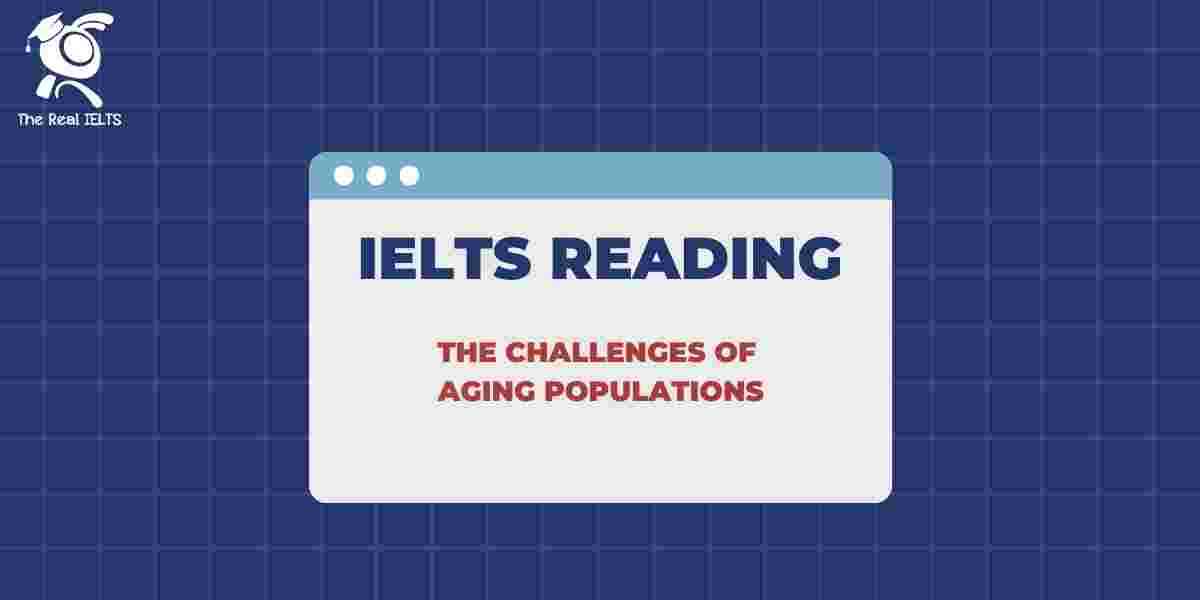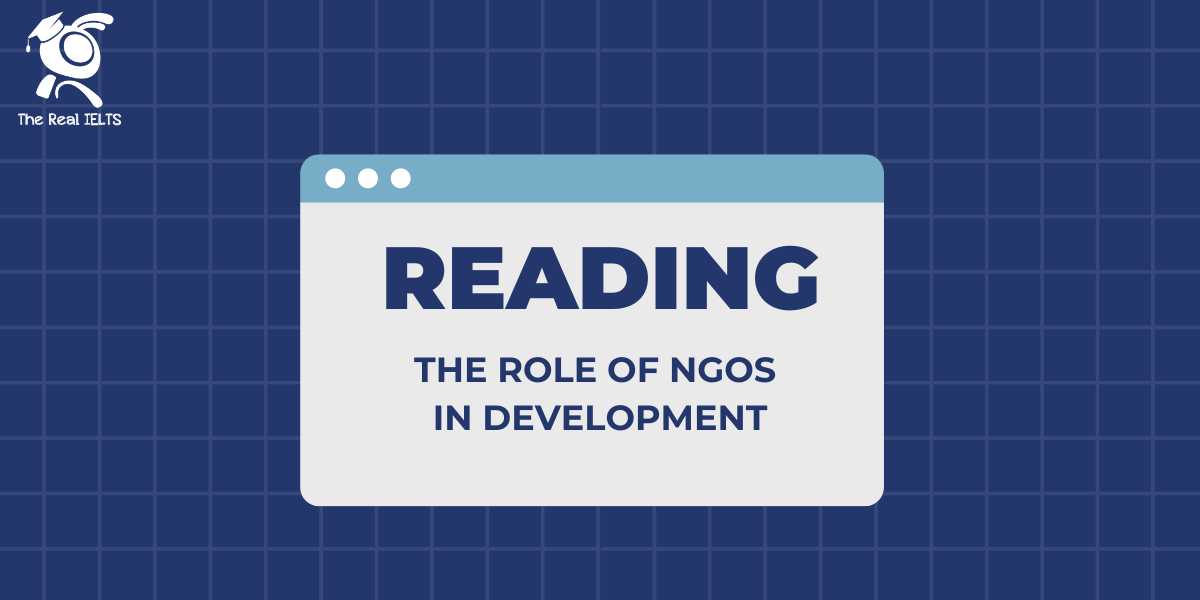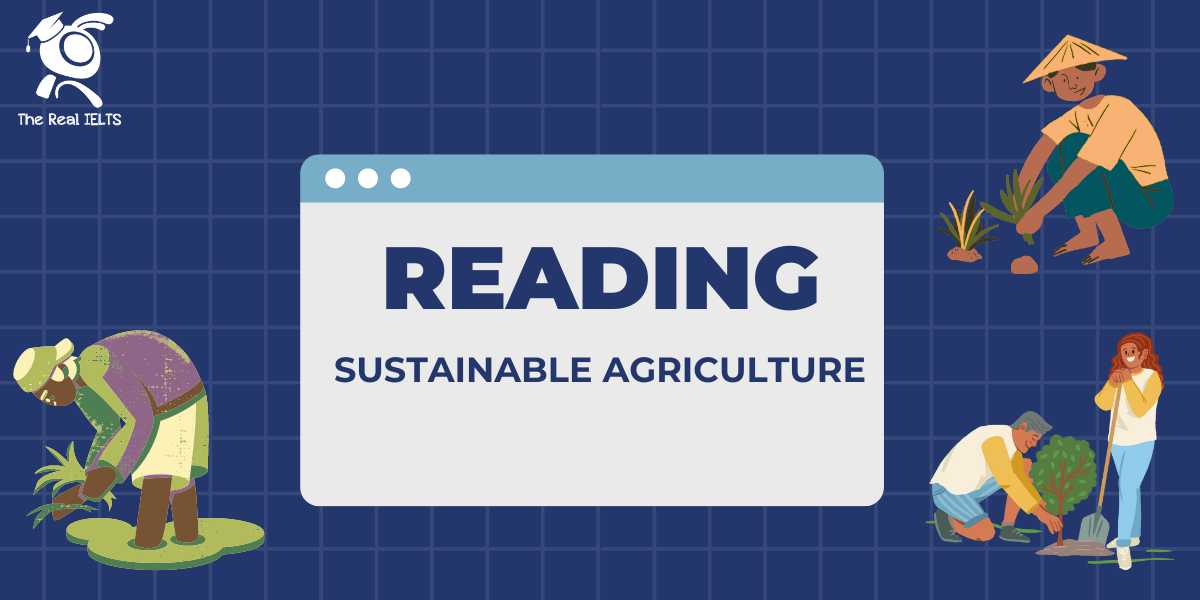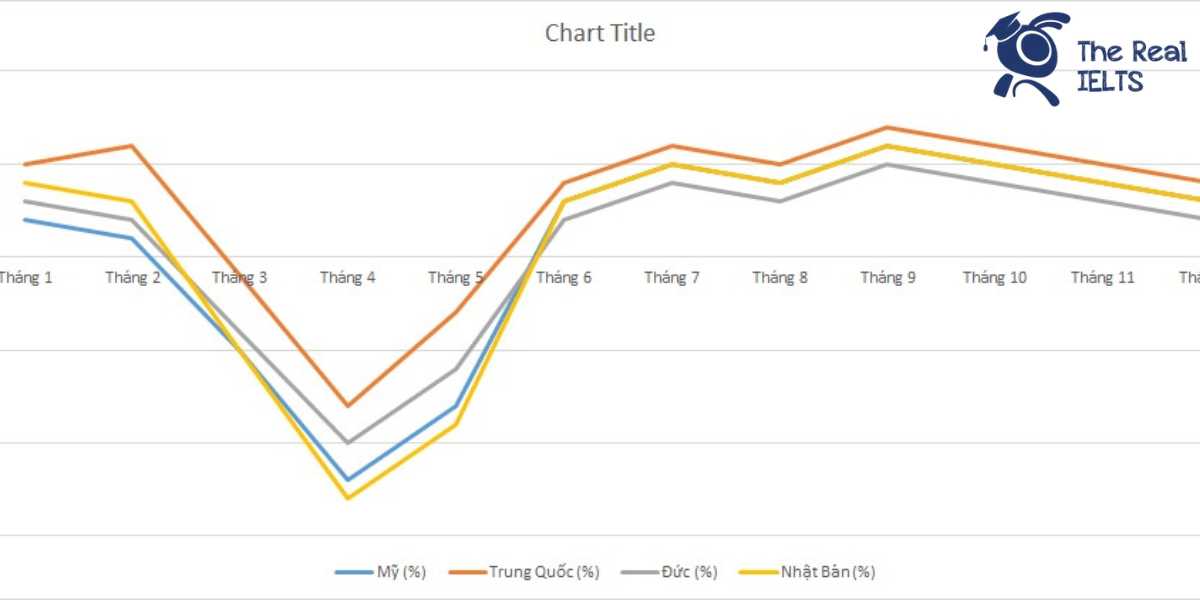Đề thi IELTS Reading có tiêu đề “The Challenges of Aging Populations”
Nhớ đọc thêm các bài luyện thi IELTS nhé.
IELTS Reading: “The Challenges of Aging Populations”
The Challenges of Aging Populations
As populations around the world continue to age, societies are increasingly confronted with a unique set of challenges that require immediate and sustained attention. The demographic shift toward older populations is a global phenomenon driven by factors such as declining birth rates, increased life expectancy, and advances in healthcare. While these developments reflect significant progress in human health and well-being, they also present complex issues that impact economies, healthcare systems, social structures, and intergenerational relationships.
One of the most pressing challenges posed by aging populations is the strain on healthcare systems. Older adults generally require more medical care than younger individuals, leading to increased demand for healthcare services, long-term care facilities, and specialized treatments. Chronic diseases such as heart disease, diabetes, and dementia are more prevalent in older age groups, necessitating ongoing medical attention and resources. This surge in demand often results in higher healthcare costs, which can be a significant burden on both public and private healthcare providers. In countries with publicly funded healthcare systems, the aging population can lead to budgetary pressures, requiring difficult decisions about the allocation of resources and the prioritization of care.
The economic implications of aging populations extend beyond healthcare. As the proportion of older adults in the population grows, the ratio of working-age individuals to retirees decreases. This demographic shift can lead to a shrinking labor force, reduced economic productivity, and increased pressure on pension systems. In many countries, pension schemes were designed based on the assumption of a relatively young population with a high number of contributors to support a smaller number of retirees. However, as life expectancy increases and birth rates decline, the financial sustainability of these systems is jeopardized. Governments may be forced to consider raising the retirement age, increasing taxes, or reducing pension benefits—measures that can be politically sensitive and socially contentious.
Moreover, the aging population also has significant social implications, particularly in terms of family dynamics and intergenerational relationships. As life expectancy rises, families may face the challenge of providing care for elderly relatives over extended periods. This responsibility often falls on the middle-aged population, who may be balancing their careers and raising children while also caring for aging parents. The emotional, physical, and financial demands of caregiving can be overwhelming, leading to stress and burnout among caregivers. In addition, the traditional family structure, which has historically relied on younger generations to care for the elderly, is evolving due to changing societal norms and the increasing mobility of younger people who may live far from their aging parents.
Another social challenge is the risk of isolation and loneliness among older adults. As people age, they may experience the loss of a spouse, friends, or social connections, leading to feelings of loneliness and depression. This social isolation can have serious consequences for mental and physical health, further exacerbating the challenges faced by aging populations. Communities and policymakers must explore innovative ways to promote social inclusion and support networks for older adults, such as senior centers, community programs, and initiatives that encourage intergenerational interaction.
In response to these challenges, governments, healthcare providers, and communities are seeking to develop strategies to address the needs of aging populations. One approach is the promotion of healthy aging, which focuses on maintaining the physical, mental, and social well-being of older adults. This can be achieved through public health campaigns that encourage healthy lifestyles, regular medical check-ups, and early intervention for chronic conditions. Additionally, advances in technology, such as telemedicine and wearable health devices, offer new opportunities for monitoring and managing the health of older individuals, potentially reducing the burden on healthcare systems.
Another important strategy is the adaptation of social and economic policies to better support aging populations. This includes reevaluating pension systems, encouraging lifelong learning and workforce participation among older adults, and investing in age-friendly infrastructure and housing. By creating environments that accommodate the needs of older individuals, societies can help ensure that aging populations remain active, engaged, and economically productive.
Furthermore, fostering intergenerational solidarity is essential for addressing the social challenges associated with aging populations. Programs that promote interaction between different age groups, such as mentorship schemes or community volunteering, can help bridge the generational gap and reduce the sense of isolation among older adults. These initiatives not only benefit older individuals but also provide younger generations with valuable life experiences and a deeper understanding of the aging process.
In conclusion, the challenges posed by aging populations are multifaceted and require comprehensive and coordinated efforts to address. As the global population continues to age, it is crucial for governments, healthcare systems, and communities to adapt to these changes and develop sustainable solutions that support the well-being of older adults. By promoting healthy aging, adapting social and economic policies, and fostering intergenerational solidarity, societies can turn the challenges of aging populations into opportunities for growth and resilience.
Đề bài thi IELTS Reading
Multiple Choice (Câu hỏi trắc nghiệm)
- What is one of the primary factors driving the aging population phenomenon?
- A) Increased immigration
- B) Declining birth rates
- C) Rising unemployment rates
- D) Global warming
- Which of the following is a major concern for healthcare systems due to aging populations?
- A) Lack of medical technology
- B) Shortage of healthcare workers
- C) Increased demand for long-term care
- D) Declining number of hospitals
- What economic issue is exacerbated by an aging population?
- A) Increased taxation
- B) Shrinking labor force
- C) Inflation
- D) Lower consumer spending
- What social challenge is particularly associated with aging populations?
- A) Increase in crime rates
- B) Decline in educational standards
- C) Isolation and loneliness among older adults
- D) Rise in child labor
- Which strategy is mentioned as a way to address the needs of aging populations?
- A) Increasing birth rates
- B) Promoting healthy aging
- C) Reducing retirement age
- D) Encouraging early retirement
- How can intergenerational solidarity be promoted according to the text?
- A) Through financial support
- B) By establishing senior-only communities
- C) By fostering interaction between different age groups
- D) By encouraging older adults to live independently
- Which of the following is NOT mentioned as a potential policy adaptation for aging populations?
- A) Re-evaluating pension systems
- B) Promoting lifelong learning
- C) Building more hospitals
- D) Investing in age-friendly infrastructure
- What is one possible consequence of a shrinking labor force?
- A) Increased economic productivity
- B) Enhanced social services
- C) Reduced economic growth
- D) Higher employment rates
True/False/Not Given
- The demographic shift toward older populations is a phenomenon limited to developed countries.
- True
- False
- Not Given
- The text mentions that the responsibility of caregiving for older adults often falls on the younger siblings.
- True
- False
- Not Given
- Social isolation can lead to serious mental health issues for older adults.
- True
- False
- Not Given
- The text suggests that traditional family structures are being strengthened by aging populations.
- True
- False
- Not Given
- The government is the only entity responsible for addressing the challenges of aging populations.
- True
- False
- Not Given
Yes/No/Not Given
- The author believes that increasing the retirement age is a sustainable solution for aging populations.
- Yes
- No
- Not Given
- The author suggests that telemedicine is the ultimate solution to the healthcare challenges posed by aging populations.
- Yes
- No
- Not Given
- The author views the promotion of healthy aging as beneficial for both individuals and society.
- Yes
- No
- Not Given
- The author is pessimistic about the possibility of adapting social and economic policies to meet the needs of aging populations.
- Yes
- No
- Not Given
Matching Information (Nối thông tin)
- Match the following strategies with the challenges they address:
- Promoting healthy aging
- Adapting social and economic policies
- Fostering intergenerational solidarity
- A) Healthcare strain
- B) Economic sustainability
- C) Social isolation
Matching Headings (Nối tiêu đề với đoạn văn)
- Match the following headings to the paragraphs in the passage:
- Economic Implications of Aging Populations
- The Role of Families in Aging Societies
- Healthcare Challenges of Aging Populations
- Strategies for Addressing Aging Populations
Matching Features (Nối đặc điểm)
- Match the following features with the corresponding aspects of the aging population discussed in the passage:
- A) Increased life expectancy
- B) Declining birth rates
- C) Advances in healthcare
- D) Evolving family structures
- Reasons for aging populations
- Challenges in healthcare
- Social implications
- Economic challenges
Matching Sentence Endings (Nối phần kết câu)
- Match the beginning of the sentences with the correct endings:
- The aging population is challenging healthcare systems because…
- Economic sustainability is threatened by aging populations due to…
- Families are increasingly responsible for elder care as a result of…
- Social isolation among older adults can lead to…
- A) Chronic diseases and increased medical needs
- B) Declining birth rates and a shrinking labor force
- C) Evolving family structures and longer life expectancy
- D) Mental health issues and physical decline
Sentence Completion (Hoàn thành câu)
- Aging populations are putting a strain on healthcare systems due to the increased demand for ________.
- The shrinking labor force in aging populations can lead to reduced ________.
- Social isolation can have serious consequences for the ________ health of older adults.
- Governments may need to raise the ________ age to maintain the financial sustainability of pension systems.
Summary Completion (Hoàn thành đoạn tóm tắt)
- The aging population is a global phenomenon caused by factors such as ________ and ________. This demographic shift is creating significant challenges for healthcare systems, including the increased need for ________ care and the treatment of chronic diseases. Economically, aging populations can lead to a shrinking ________, putting pressure on pension systems. Socially, families face the challenge of providing care for older relatives, which can lead to ________ and ________ among caregivers.
Note Completion (Hoàn thành ghi chú)
- Healthcare Challenges: Increased demand for medical services, especially ________ diseases.
- Economic Challenges: Shrinking ________, unsustainable pension systems.
- Social Challenges: Isolation, ________ among caregivers.
Table Completion (Hoàn thành bảng)
| Challenge | Example |
|---|---|
| Healthcare | Increased demand for ________ |
| Economic | Shrinking labor force leading to ________ |
| Social | Caregiving responsibilities causing ________ |
Diagram Label Completion (Hoàn thành nhãn của sơ đồ)
- Complete the labels for the following diagram related to the economic impact of aging populations:
- A) Shrinking labor force
- B) Increased ________
- C) Pressure on ________ systems
Short Answer Questions (Câu hỏi trả lời ngắn)
- What is one factor that has contributed to the aging population?
- Name a chronic disease that is more prevalent in older age groups.
- What is one consequence of a shrinking labor force?
- How can social isolation affect older adults?
- What is one strategy mentioned to support healthy aging?
Additional Multiple Choice Questions
- Which age group is likely to face the most pressure in caregiving for older adults?
- A) Young adults
- B) Middle-aged adults
- C) Elderly
- D) Teenagers
- What is the author’s attitude towards the economic impact of aging populations?
- A) Concerned
- B) Indifferent
- C) Optimistic
- D) Neutral
- What does the author suggest is a possible solution for the financial strain on pension systems?
- A) Lowering pension benefits
- B) Increasing taxes
- C) Raising the retirement age
- D) Expanding the labor force
- What does the text imply about the future of healthcare systems in aging societies?
- A) They will require significant reforms.
- B) They are already well-prepared.
- C) They will face fewer challenges.
- D) They will be less important.
- Which of the following is an advantage of promoting intergenerational solidarity?
- A) Reducing economic strain
- B) Enhancing social inclusion
- C) Improving healthcare technology
- D) Lowering the retirement age
Đáp án bài thi IELTS Reading
Multiple Choice (Câu hỏi trắc nghiệm)
- B) Declining birth rates
- C) Increased demand for long-term care
- B) Shrinking labor force
- C) Isolation and loneliness among older adults
- B) Promoting healthy aging
- C) By fostering interaction between different age groups
- C) Building more hospitals
- C) Reduced economic growth
True/False/Not Given
- False (The aging population is described as a global phenomenon, not limited to developed countries.)
- Not Given (The text does not specify that the responsibility falls on younger siblings.)
- True (Social isolation can have serious consequences for mental and physical health.)
- False (The text suggests that traditional family structures are evolving, not strengthening.)
- False (The text mentions governments, healthcare providers, and communities as responsible entities.)
Yes/No/Not Given
- Not Given (The text discusses raising the retirement age but does not express a clear opinion on its sustainability.)
- No (The text mentions telemedicine as an opportunity but not as the ultimate solution.)
- Yes (The text supports the promotion of healthy aging as beneficial.)
- No (The text suggests that adapting policies is necessary and implies it is possible.)
Matching Information (Nối thông tin)
- Promoting healthy aging → A) Healthcare strain
- Adapting social and economic policies → B) Economic sustainability
- Fostering intergenerational solidarity → C) Social isolation
Matching Headings (Nối tiêu đề với đoạn văn)
- Economic Implications of Aging Populations → Paragraph 2
- The Role of Families in Aging Societies → Paragraph 3
- Healthcare Challenges of Aging Populations → Paragraph 1
- Strategies for Addressing Aging Populations → Paragraph 5
Matching Features (Nối đặc điểm)
- Reasons for aging populations → A) Increased life expectancy, B) Declining birth rates
- Challenges in healthcare → C) Advances in healthcare
- Social implications → D) Evolving family structures
- Economic challenges → B) Declining birth rates
Matching Sentence Endings (Nối phần kết câu)
- The aging population is challenging healthcare systems because… → A) Chronic diseases and increased medical needs
- Economic sustainability is threatened by aging populations due to… → B) Declining birth rates and a shrinking labor force
- Families are increasingly responsible for elder care as a result of… → C) Evolving family structures and longer life expectancy
- Social isolation among older adults can lead to… → D) Mental health issues and physical decline
Sentence Completion (Hoàn thành câu)
- Aging populations are putting a strain on healthcare systems due to the increased demand for long-term care.
- The shrinking labor force in aging populations can lead to reduced economic productivity.
- Social isolation can have serious consequences for the mental health of older adults.
- Governments may need to raise the retirement age to maintain the financial sustainability of pension systems.
Summary Completion (Hoàn thành đoạn tóm tắt)
- The aging population is a global phenomenon caused by factors such as increased life expectancy and declining birth rates. This demographic shift is creating significant challenges for healthcare systems, including the increased need for long-term care and the treatment of chronic diseases. Economically, aging populations can lead to a shrinking labor force, putting pressure on pension systems. Socially, families face the challenge of providing care for older relatives, which can lead to stress and burnout among caregivers.
Note Completion (Hoàn thành ghi chú)
- Healthcare Challenges: Increased demand for medical services, especially chronic diseases.
- Economic Challenges: Shrinking labor force, unsustainable pension systems.
- Social Challenges: Isolation, stress among caregivers.
Table Completion (Hoàn thành bảng)
| Challenge | Example |
|---|---|
| Healthcare | Increased demand for long-term care |
| Economic | Shrinking labor force leading to reduced productivity |
| Social | Caregiving responsibilities causing stress and burnout |
Diagram Label Completion (Hoàn thành nhãn của sơ đồ)
- Complete the labels for the following diagram related to the economic impact of aging populations:
- A) Shrinking labor force
- B) Increased pressure on pension systems
- C) Pressure on healthcare systems
Short Answer Questions (Câu hỏi trả lời ngắn)
- Increased life expectancy and declining birth rates.
- Heart disease or dementia.
- Reduced economic productivity.
- Mental health issues or depression.
- Healthy aging promotion.
Additional Multiple Choice Questions
- B) Middle-aged adults
- A) Concerned
- C) Raising the retirement age
- A) They will require significant reforms.
- B) Enhancing social inclusion
Luyện tập bài khác ở bài viết:”100 bài luyện IELTS Reading 2024 – 2025“















